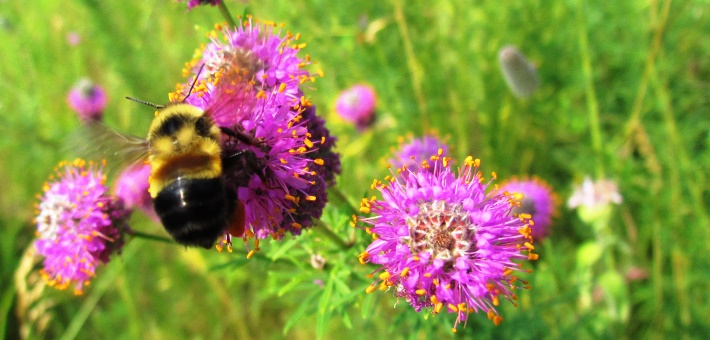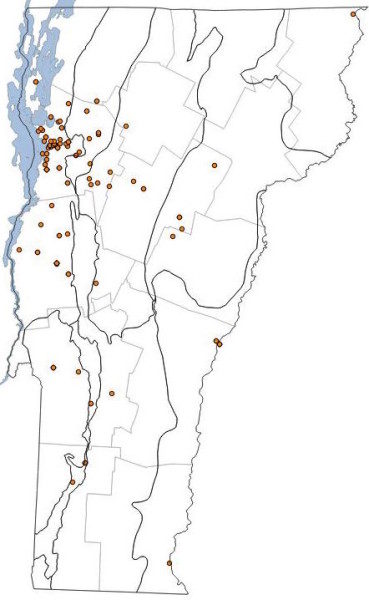Just 20 years ago, the rusty patched bumble bee was a common sight, so ordinary that it went almost unnoticed as it moved from flower to flower, collecting nectar and pollen. But the species, now balancing precariously on the brink of extinction, has become the first-ever bumble bee in the United States — and the first bee of any kind in the contiguous 48 states — to be declared federally endangered.
The endangered designation is made by the U.S. Fish and Wildlife Service under the Endangered Species Act for species that are in danger of becoming extinct throughout all or a portion of their range. Service Midwest Regional Director Tom Melius said, “Our top priority is to act quickly to prevent extinction of the rusty patched bumble bee. Listing the bee as endangered will help us mobilize partners and focus resources on finding ways right now to stop the decline.”

The number of Rusty-patched Bumble Bees found by University of Vermont entomology students each decade.
Once common and abundant across 28 states from Connecticut to South Dakota, the District of Columbia and two Canadian provinces, the rusty patched bumble bee has experienced a swift and dramatic decline since the late 1990s. It was last found in Vermont in 1999 according to Vermont Center for Ecostudies’ Vermont Bumble Bee Atlas. Abundance of the rusty patched bumble bee has plummeted by 87 percent, leaving small, scattered populations in 13 states and one province.
“The rusty patched bumble bee is among a group of pollinators – including the monarch butterfly – experiencing serious declines across the country,” Melius said. “Why is this important? Pollinators are small but mighty parts of the natural mechanism that sustains us and our world. Without them, our forests, parks, meadows and shrublands, and the abundant, vibrant life they support, cannot survive, and our crops require laborious, costly pollination by hand.”
Like other bees, rusty patched bumble bees pollinate many plants, including economically important crops such as tomatoes, cranberries and peppers. Bumble bees are especially good pollinators; even plants that can self-pollinate produce more and bigger fruit when pollinated by bumble bees. Each year, insects, mostly bees, provide pollination services valued at an estimated $3 billion in the United States.
Since 2000, rusty patched bumble bees have been reported in Illinois, Indiana, Iowa, Maine, Maryland, Massachusetts, Minnesota, North Carolina, Ohio, Pennsylvania, Tennessee, Virginia and Wisconsin, and Ontario, Canada. Some populations are so small that it is unclear whether they still exist.
Causes of the decline in rusty patched bumble bee populations are believed to be loss of habitat; disease and parasites; use of pesticides that directly or indirectly kill the bees; climate change, which can affect the availability of the flowers they depend on; and extremely small population size. Most likely, a combination of these factors has caused the decline in rusty patched bumble bees.
Melius says there are steps the public can now take to help pollinators like the rusty patched bumble bee. Plant native flowers, even in small plots in urban areas, using a variety that will bloom from spring through fall. Limit or avoid use of pesticides if possible, and always follow label instructions carefully. Foster natural landscapes and leave grass and garden plants uncut after summer to provide habitat for overwintering bees.
The rusty patched bumble bee once lived in grasslands and prairies of the Upper Midwest and Northeast, but many of those areas are gone. The bee gathers pollen and nectar from a variety of flowering plants. It emerges in early spring and is one of the last bumble bee species to go into hibernation in the fall. Because it is active so long, it needs a constant supply of flowers blooming from April through September.
Rusty patched bumble bee colonies rely on survival of their queen bee, the only member of the colony that survives the winter. In spring, a solitary queen emerges from hibernation, finds a suitable nest site and lays eggs fertilized the previous fall. Worker bees hatch, and the colony grows. New queens replace the old, all workers die and the cycle repeats.
The final rule listing the rusty patched bumble bee as endangered appears in the January 11, 2017, Federal Register and takes effect on February 10, 2017.
Source: USFWS press release at https://www.fws.gov/midwest/news/861.html



We seem to have a large flock of yellow rumped warblers at our
neighbors pond they settled in last summer and have returned this year. another neighbor is building near the pond and we are worried about the habitat.
Great to have access to your website